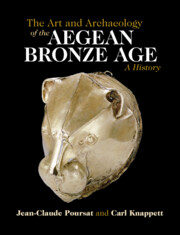Book contents
- The Art and Archaeology of the Aegean Bronze Age
- The Art and Archaeology of the Aegean Bronze Age
- Copyright page
- Contents
- Figures
- Introduction
- Part I Aegean Neolithic Art
- Part II The Art of the Aegean Early Bronze Age
- Part III Aegean Art in the Cretan First Palace Period
- Part IV Aegean Art in the Second Palace Period
- Chapter 19 Artworks in Context
- Chapter 20 Aegean Architecture in the Second Palace Period
- Chapter 21 Aegean Wall Painting
- Chapter 22 Minoan Glyptic
- Chapter 23 Artworks in the Round
- Chapter 24 Other Artworks (Stone, Faience, Ivory, Metal, and Textile)
- Chapter 25 Pottery Production
- Part V Aegean Art in the Cretan Second Palace Period
- Part VI Aegean Art in the Final Palatial Period of Knossos
- Part VII Aegean Art of the Mainland Mycenaean Palatial Period
- Part VIII Aegean Art at the End of the Bronze Age
- Afterword Aegean Art Through Forgers’ Eyes
- References
- Index
- Plate Section (PDF Only)
- References
Chapter 23 - Artworks in the Round
Figures, Figurines, and Zoomorphic Vases
from Part IV - Aegean Art in the Second Palace Period
Published online by Cambridge University Press: 19 May 2022
- The Art and Archaeology of the Aegean Bronze Age
- The Art and Archaeology of the Aegean Bronze Age
- Copyright page
- Contents
- Figures
- Introduction
- Part I Aegean Neolithic Art
- Part II The Art of the Aegean Early Bronze Age
- Part III Aegean Art in the Cretan First Palace Period
- Part IV Aegean Art in the Second Palace Period
- Chapter 19 Artworks in Context
- Chapter 20 Aegean Architecture in the Second Palace Period
- Chapter 21 Aegean Wall Painting
- Chapter 22 Minoan Glyptic
- Chapter 23 Artworks in the Round
- Chapter 24 Other Artworks (Stone, Faience, Ivory, Metal, and Textile)
- Chapter 25 Pottery Production
- Part V Aegean Art in the Cretan Second Palace Period
- Part VI Aegean Art in the Final Palatial Period of Knossos
- Part VII Aegean Art of the Mainland Mycenaean Palatial Period
- Part VIII Aegean Art at the End of the Bronze Age
- Afterword Aegean Art Through Forgers’ Eyes
- References
- Index
- Plate Section (PDF Only)
- References
Summary
Was there ever such a thing as Minoan monumental statuary? There is no direct evidence. The terracotta figures from Kea (see below, p. 218), as much as 1.6 m tall, have no real Cretan precursors: the largest Protopalatial figurines, from Petsophas and Sklaverochori, are fragmentary and hardly surpass 70 cm, while the mould for a life-size bronze hand from Phaistos is difficult to interpret (see above, p. 112). Evans believed that the bronze hairlocks from the palace of Knossos formed part of the headdress of a colossal wooden statue; it has since been shown that in fact they most likely belong to rather small wooden figurines (R. Hägg, AA 1983, 543–9). The discovery at Archanes (Anemospilia) of large terracotta feet has nevertheless revived the debate: are these simply votive feet, as known from other examples on Crete and Kea, or should we see them as supports intended to slot into a wooden statue (xoanon) that has since decayed?.
- Type
- Chapter
- Information
- The Art and Archaeology of the Aegean Bronze AgeA History, pp. 209 - 224Publisher: Cambridge University PressPrint publication year: 2022

